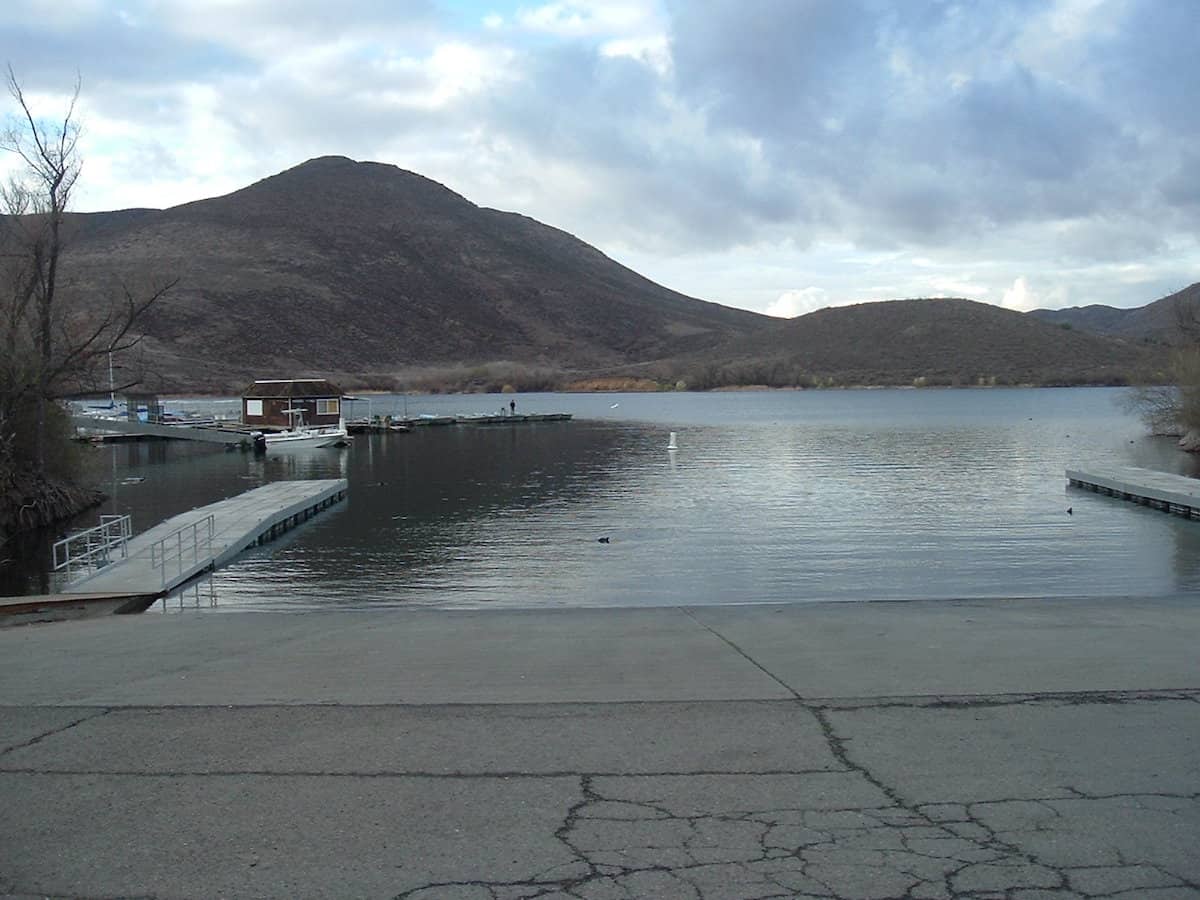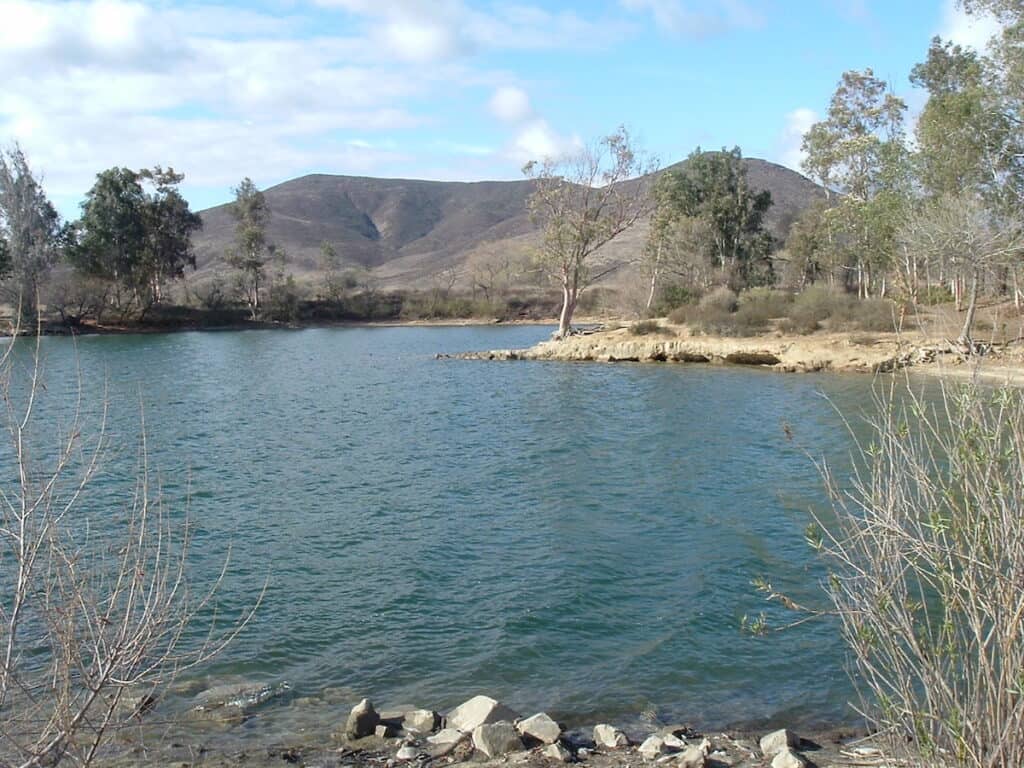Lake Skinner is located in rolling hills just east of Temecula, but it feels like it’s worlds apart.
The serene setting in a popular regional park and the absence of speed boats and water skiers due to speed limits help make this reservoir a perfect fishing getaway.
Whether you are after stripers, largemouth bass, rainbow trout, or channel catfish, you’re apt to do well fishing at Lake Skinner. There are also good numbers of other fish species, including panfish, in the lake.
Lake Skinner these days is perhaps best known for its striped bass fishing, though, through good fisheries management practices, it has something for just about everyone.
Lake Skinner is quickly becoming recognized as a premier largemouth bass fishery and is a solid bet for rainbow trout during the cool months and channel catfish during the warm months, as it’s stocked regularly with both gamefish.
Since it’s just over 70 miles from downtown San Diego, it does get pretty busy throughout the late winter through mid-summer, when fishing is best.
There aren’t too many water sport enthusiasts around this lake as it only has on small swimming beach, and swimming isn’t generally allowed in the main reservoir.
The Metropolitan Water District operates Lake Skinner (also known as Skinner Reservoir or Skinner Lake) and are pretty strict about access. Float tubes aren’t allowed, and there are higher standard requirements for boat emissions.
Make sure you check out any regulation changes at the lake before heading up.
Striper Fishing
There are a lot of striped bass in here. If you’re in search of excellent table fare, hit Lake Skinner.
There are days that you can catch your 10-fish limit in minutes. While these stripers probably won’t break 5 pounds, they are plentiful and provide a fun fight on trout gear.
Head out to the inlet area if you’re on a boat, and you can catch smaller stripers with almost every cast under the right circumstances. If the stars align, it can be some of the best fishing you’ve had.
Of course, this being called fishing and not catching, there are also days when the striper bite shuts off and you might bring one in all day.
Keep your spirits up and try again next time. It may fish like an entirely different lake trip to trip, but getting to know the fishing patterns here will boost your catches over time.
Topwater fishing can be fantastic in the spring and fall. Late fall in the morning can be incredibly productive.
Watch for baitfish on the surface and then cast just to the other side of them. Bring it back in fast, and you might get one to explode through the surface to take your bait.
Ramp 2 is another good spot in the mornings. Try tossing some jerk baits across the launch, and you might find a few takers.
If nothing’s happening around the ramp, throw some cut baits or anchovies at the buoy line.
You’ll probably either find some stripers or some catfish. Either way, you’re in for a good fight and a good meal.
One of our California contributors, Jeffrey Walters, offered some tips from his experience catching stripers on bait at Lake Skinner.
He likes to use a larger rod, like you might for surf fishing, to cast 1 ounce or more of weight. Below the weight, tie on a 2- to 3-foot leader with a medium-sized treble hook.
He would bait that hook with frozen mackerel or anchovies, wrapping the bait with black thread to keep it on the hook.
Next, cast as far out as you can and close the bail as soon as the weight hits the water. Bring in all the bait as fast as you can because the stripers hit the bait as it sinks, often in about 20 feet of water. You need to be ready to set the hook.
If you aren’t using heavy weight, you likely can get away with standard trout or bass fishing gear at Lake Skinner. Most of the stripers aren’t huge, with a few larger ones few and far between.
Late fall can also provide a rare opportunity to catch stripers on the fly.
Use a fly rod and toss some bass poppers at an area with a bunch of baitfish, and you’ll be sure to find some.
Lake Skinner is on our list of the best striper fishing lakes in California.
Largemouth Bass Fishing
The largemouth bass in Lake Skinner are, in some anglers’ eyes, becoming a bigger draw than the stripers. That’s because the largies in here have been getting big.
If hooking into a bucketmouth is what draws you to the water, this lake should be on your shortlist.
With no water skiing or jet skis swarming the spawning beds, bass have been able to take hold here and proliferate.
Every year rainbow trout are planted several times, and by the time the largemouth spawn comes around, the trout are almost impossible to find.
Big largemouths love to eat rainbows, and they’re good at it.
With that in mind, swimbaits, crankbaits and other lures that a bass might see as an easy trout meal should be among your arsenal at Lake Skinner.
If fishing from a boat, target the shallower areas around the edges of drop-offs and any sunken coverage you can find.
While much of the deeper water is fairly barren, those ledges and the weed lines along the perimeter will attract bass.
You’ll find all the bass fishing techniques you need in this how-to guide.
Rainbow Trout Fishing
Trout fishing here is definitely prime in the colder winter months, when there are lots of stocked fish and the trout are on the feed.
Going very far into springtime, it gets pretty challenging to find any in the lake. There are some in there, but the survivors are wily and not willing to take any old the bait.
There are several stocking events every fall and winter, with the last one coming around the first of spring.
Waiting until April or May to target them is far too late for good trout fishing. They’ve either been caught, eaten by largemouth bass or stripers, or have taken refuge in the deeper reaches of the lake.
In the colder months, use the same tactics you would use elsewhere to catch rainbows.
PowerBait, Rapalas, spinners and Jakes Lures are all excellent options. You might catch a random bass or two while you’re at it.
Find more trout fishing tactics in our easy guide.
Channel Catfish Fishing
Channel cats are regularly stocked at Lake Skinner from spring to September and are spread throughout the lake. They can be caught all year but the catfish action is best in the warmer months.
If you’re targeting catfish, think stink baits and chicken livers. Sure, nightcrawlers work as well but will draw in the smaller bluegill that will clean your hook for you.
Shore fishing can be a bit of a challenge for cats since there are a good number of weeds in shallower water near the bank. It’s pretty common to see anglers using surf rods to get their bait out past the weed bed.
From shore, fish the beach near Dock 1 and Dock 2.
At Dock 2, you may also run into schools of stripers roaming around. These fish often aren’t very big but are super tasty.
Want some more ideas of the best catfish fishing baits and tips?
Bluegill and Redear Sunfish
These sunfish species can get to good sizes at Lake Skinner.
The lake record for redear is over three pounds, which is an impressive slab of panfish.
The usual bluegill and sunfish fishing tactics work well, though sometimes panfish become more of an annoying bait stealer when targeting other species.
Bluegill are known to bite some of the same baits as the channel cats here, especially any type of worm or insect baits.
So, there you are, fishing for a channel cat, and your line starts bouncing. You set the hook and think you’ve caught nothing until there is suddenly a bluegill on the end of your line.
They’re pretty prevalent in here, so plan accordingly. Cut bait, anyone?
You might also catch a few black crappie.
Planning Your Trip
Getting to Lake Skinner won’t take too long. Located in southwestern Riverside County, it’s just maybe a half hour east of Temecula and within a couple hours’ drive of the Los Angeles, Orange County or San Diego areas.
It’s also near other popular lakes, including Diamond Valley Lake, Lake Elsinore and Lake Perris.
With its location being so close to major metropolitan areas, you’d think this lake should be skipped.
Luckily the management of the lake has been targeted towards anglers and not the powerboat set. A 10 mph speed limit is in place throughout the lake, limiting boating activities to the slower and quieter types.
If you are into a variety of recreational opportunities, there are great hiking and biking trails around the lake, along with horseback riding.
If dipping into the lake is on your menu, sorry, no body contact with the lake water is allowed, but there is a splash pad where you can cool off.
If you have a boat, be sure to check out the inlet area. When water is flowing, there can be a powerful waterfall and frothy area that’s cool to see.
But don’t tie off to the buoy line, or you’ll get kicked out of the lake.
Boat and Shore Access
Lake Skinner has two boat ramps. There is plenty of parking and access is easy.
Boat rentals also are available at Lake Skinner Marina on the north side of Lake Skinner Recreation Area.
Lake Skinner Shore Fishing
Bank angling can be good for most species, including trout, catfish and more.
Shore access is readily available in several areas, especially at the east end of the reservoir around the recreation area.
The more popular bank fishing options are near the two ramps as well as directly across the lake from Dock 2. Paths lead to many of the better spots close to parking as well as around to the other side of the cove at the reservoir’s southeast corner.
Be sure to keep up to date on any new regulations for this lake, as the Metropolitan Water District of Southern California manages recreation here.
Keep in mind that float tubes and similar floating devices are not allowed here. Checks for quagga mussels are in place as well, so be ready. Your boat must be clean and dry to get access.
Where to Stay
Lake Skinner Park has a large campground with over 100 full hook-up sites and quite a few water and electric sites, with additional water-only sites. You can also find over 100 primitive tent sites.
Temecula is just down the road, so if a hotel and restaurants are more your speed, make plans to stay there.
If you need something you can’t find at the camp store, food and essentials are all available in Temecula as well. There are stores that will fill all of your bait and tackle needs, so if you forget something, you’re covered.
The lake sees a significant amount of fishing pressure, but with careful management, they’ve been able to meet demand.


